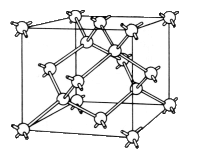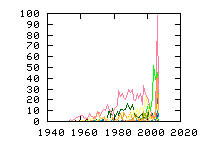« Previous
1
Next »
(4 hits, 1/1)
Showing
10, 25, 50, 100, 500, 1000, all papers per page.
Sort by:
last publication date,
older publication date,
last update date.
- 1. J. Appl. Phys. 100, 104901 (2006) , “Photoluminescence and photoconductivity in CdTe crystals doped with Bi”, E. Saucedo, C. M. Ruiz, V. Bermúdez, E. Dieguez, E. Gombia, A. Zappettini, A. Baraldi, and N. V. SochinskiiDefect levels in CdTe doped with Bi are studied by low temperature photoluminescence, photoinduced current transient spectroscopy, photoconductivity measurements, and optical absorption. Two centers associated with the doping with Bi are reported. The first one, a deep level located at... (Read more)
- 2. Phys. Rev. 134, A265 (1964) , “Electron Spin Resonance Experiments on Shallow Donors in Germanium”, D. K. WilsonAt liquid helium temperatures, spin resonance of localized donor electrons has been observed in phorphorus-, arsenic-, and bismuth-doped germanium. The presence of hyperfine splitting confirms the singlet as the ground state for all three. The separation of the excited triplet states has been... (Read more)
- 3. Phys. Rev. 114, 1219 (1959) , “Electron Spin Resonance Experiments on Donors in Silicon. I. Electronic Structure of Donors by the Electron Nuclear Double Resonance Technique”, G. Feher.The ground-state wave function of the antimony, phosphorus, and arsenic impurities in silicon has been investigated by means of the electron nuclear double resonance (ENDOR) method. By this method the hyperfine interactions of the donor electron with the Si29 nuclei situated at different... (Read more)
- 4. Solid State Physics 5, 258-319 (1957) , Academic Press, New York (Edited by F. Seitz, D. Turnbull) , “Shallow Impurity States in Silicon and Germanium”, W. KohnI. Introduction (p.258): II. Emprical Properties (p.261): 1. Energy Levels (p.261), a. Ionization Energies, b. Spectra of Excited States, 2. Spin Resonance (p.266), a. Electron Spin Resonance, b. Double Resonance, 3. Static Magnetic Susceptibility (p.271), III. Structure of Donor States (p.271): 4. Conduction Bands of Silicon and Germanium (p.271), a. Silicon, b. Germanium, 5. Effective Mass Theory of Donor States (p.274), a. Single Band Minimum at k=0, b. Several Conduction Band Minima, c. Matrix Elements for Radiative Transitions, 6. Numerical Results and Comparison with Experiments (p.285), a. Energy Levels, b. Wave Functions, 7. Corrections to the Effective Mass Formalism (p.289), a. General Considerations, b. Corrected Wave Functions, c. Comparison with Experiment, IV. Structure of Acceptor States (p.297): 8. Valence Bands of Silicon and Germanium (p.297), a. Silicon, b. Germanium, 9. Effective Mass Equations for Acceptor States (p.300), 10. Approximate Solutions and Comparison with Experiment (p.301) a. Germanium b. Silicon V.Effects of Strains and of Static Electric and Magnetic Fields (p.306): 11. Strains (p.306) a. Donor States, b. Acceptor States, 12. Stark Effect (p.311)
« Previous
1
Next »
(4 hits, 1/1)
Showing
10, 25, 50, 100, 500, 1000, all papers per page.
Sort by:
last publication date,
older publication date,
last update date.
All papers (3399)
Updated at 2010-07-20 16:50:39
Updated at 2010-07-20 16:50:39
(view as: tree
,
cloud
)
| 1329 | untagged |
Materials
(111 tags)
Others(101 tags)
Technique
(46 tags)
Details
(591 tags)
Bond(35 tags)
Defect(interstitial)(18 tags)
Defect(vacancy)(15 tags)
Defect-type(19 tags)
Element(65 tags)
Energy(8 tags)
Isotope(56 tags)
Label(303 tags)
Sample(17 tags)
Spin(8 tags)
Symmetry(15 tags)

